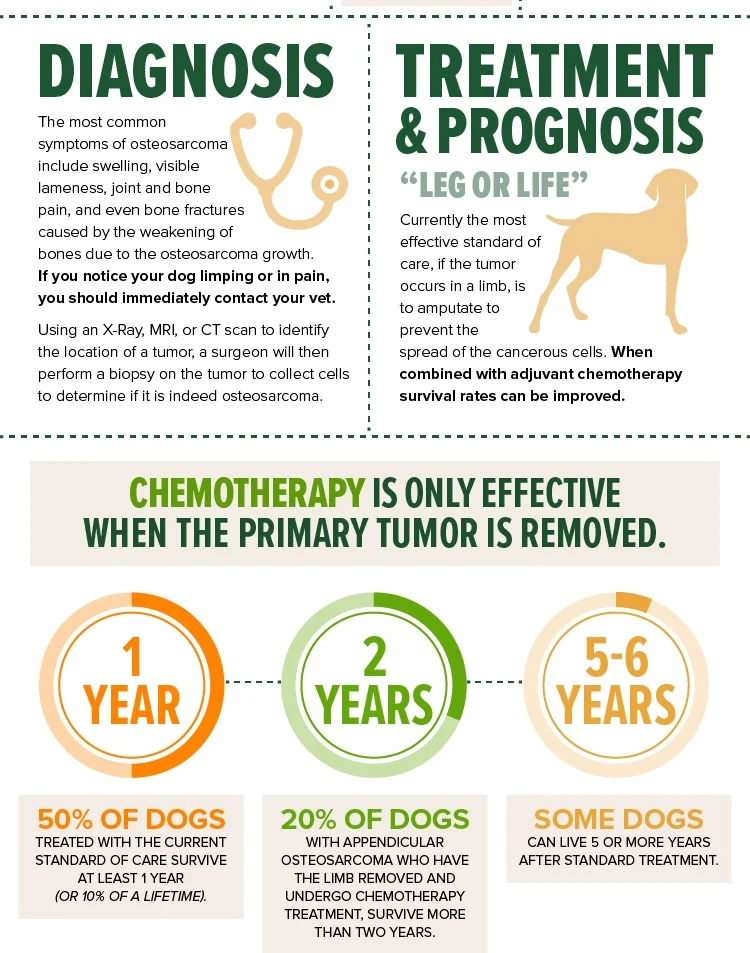Canine Bone Cancer: The Big Story on Osteosarcoma in dogs: Developed by Orvis.
Osteosarcoma is an aggressive cancerous tumor that develops in the bone cells of a dog and rapidly spreads throughout the body resulting in death.
There is currently no cure for this type of bone cancer.
Most common breeds affected by osteosarcoma
While any breed can get bone cancer the breeds that are often diagnosed with osteosarcoma are Boxers, Doberman Pinschers, Golden Retrievers, German Shepherd Dogs, Great Danes, Great Pyrenees, Greyhounds, Irish Setters, Irish Wolfhounds, Labrador Retrievers, Newfoundlands, Rottweilers, Saint Bernards, and Weimaraners.

Osteosarcoma By The Numbers:
- 10,000 dogs diagnosed with osteosarcoma each year.
- Osteosarcoma occurs 10x more frequently in dogs than humans.
- 20% to 50% greater risk for male dogs.
- Accounts for roughly 5% of all canine tumors and 85% of all canine bone tumors.
- 80% of dogs die within two years of diagnosis and in 90% of cases, cancer has already spread upon diagnosis.
- 4,000 – 8,000 dogs die annually from metastatic disease.
Osteosarcoma is linked to rapid growth and it is more common in large and giant breed dogs.
To counteract this trend, large and giant breed puppy food has reduced levels of available energy, designed to slow the time needed for large breed puppies to reach their maximum size.

Believed to be fundamentally a genetic disease, there is currently no definitive connection between family members, yet osteosarcoma is certainly more prevalent in some breeds.
- 75% – 85% of osteosarcoma cases occur in the limbs.
- 15% of all Scottish Deerhounds die from osteosarcoma.
- Dogs over 80 lbs. are 60 times more likely to develop osteosarcoma than dogs weighing less than 75 lbs.
- Two of the most common causes that can be linked to osteosarcoma in dogs are rapid growth and blunt bone injury.
Diagnosis of Bone Cancer in Dogs
The most common symptoms of osteosarcoma in dogs include swelling, visible lameness, joint and bone pain, and even bone fractures caused by the weakening of bones due to the osteosarcoma growth. If you notice your dog limping or in pain, you should immediately contact your vet.
Using an X-Ray, MRI, or CT scan to identify the location of a tumor, a surgeon will then perform a biopsy on the tumor to collect cells to determine if it is indeed osteosarcoma.
Treatment and Prognosis of Osteosarcoma in Dogs
“Leg of Life”
Currently, the most effective standard of care, if the tumor occurs in a limb, is to amputate to prevent the spread of the cancerous cells. When combined with adjuvant chemotherapy survival rates can be improved.

CHEMOTHERAPY IS ONLY EFFECTIVE WHEN THE PRIMARY TUMOR IS REMOVED.
- 1 Year: 50% of dogs treated with the current standard of care survive at least 1 year (or 10% of a lifetime).
- 2 Years: 20% of dogs with appendicular osteosarcoma who have the limb removed and undergo chemotherapy treatment, survive more than two years.
- 5 – 6 years: Some dogs can live 5 or more years after the standard treatment.
The Future Of Treatment of Osteosarcoma in dogs
- $5 Million for 5 Years of Research Morris Animal Foundation has committed $5 million in new research, funding the next five years in the battle against osteosarcoma in dogs.
- Rapamycin A bacterium-derived drug that has traditionally been used to prevent rejection in organ transplants. It works by preventing the activation of T cells and B Cells. A previous study found that Rapamycin showed promise in the treatment of osteosarcoma in dogs. Two offshoot clinical trials are currently underway to study the effectiveness of Rapamycin in post-surgery treatment of metastatic disease.
- Human Clues Recent studies have shown that the fibroblast growth factor signaling pathway is abnormally activated in a variety of human tumors. MORRIS ANIMAL FOUNDATION researchers are investigating the role of this pathway in bone cancer spread and its potential as a new therapeutic target. TAILORING TREATMENT TO INDIVIDUALS – cancer gene signatures have been shown to be good predictors of how a tumor will respond to a specific chemotherapy drug.
HOW YOU CAN HELP
With the continued support of Morris Animal Foundation by Orvis and people like you, answers to treatment and survival of osteosarcoma in dogs are within reach.
Visit morrisanimalfoundation.org for more information about the fight against osteosarcoma and Morris Foundation’s many other projects.
You can help in the fight against canine cancer through the Orvis Cover Dog Contest. Visit orvis.com/coverdog to get started.
REFERENCES
All information sourced from the Morris Animal Foundation.
Misty Shores Chesapeakes
Thursday 5th of May 2016
Good information. I lost my first Chesapeake to Osteosarcoma. It was devastating. Amputation was not an option since she was 11 and I would not put her through that. I had about 14 weeks with her from the day of diagnosis.
nichole
Wednesday 4th of May 2016
I wish we got about 2 years with Lola... sadly, we didn't even get 2 months. :(
Callie, Shadow, and Ducky's Mom
Wednesday 4th of May 2016
Oh Jen, when I first saw the email, my heart sunk. I thought "Oh No! Not Sherman or Leroy, please God!" You can imagine the relief when I opened it and saw the infographic. Anyway, once I got through the sobering facts, I appreciated your sharing it all. Canine osteosarcoma - or any canine cancer for that matter - is every dog owner's nightmare as Mary Hone said.
M. K. Clinton
Wednesday 4th of May 2016
I pray that we never have to deal with cancer in any form. It is so scary.
K-koira
Wednesday 4th of May 2016
The thought of my dog getting any kind of cancer is pretty scary. I know a number of greyhound owners who have had osteo touch their lives, and I wouldn't wish it on my worst enemy. A cure for cancer of all kinds is desperately needed.